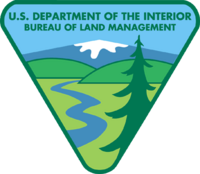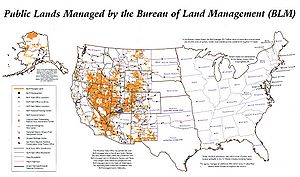Bureau Of Land Management
 From Conservapedia
From Conservapedia 
The Bureau of Land Management (BLM) The Bureau of Land Management (BLM) was established in 1946 through the consolidation of the General Land Office (created in 1812) and the U.S. Grazing Service (formed in 1934). The functions of the BLM are also addressed in the Federal Land Policy and Management Act of 1976 (FLPMA).
The BLM is responsible for carrying out a variety of programs for the management and conservation, of resources on 253 million surface acres, as well as 700 million acres of subsurface mineral estate, These public lands make up about 13 percent of the total land surface of the United States and more than 40 percent of all land managed by the Federal government.

Most of the public lands are located in the Western United States, including Alaska, and are characterized predominantly by extensive grassland, forest, high mountain, arctic tundra, and desert landscapes. The BLM manages multiple resources and uses, including energy and minerals; timber; forage; recreation; wild horse and burro herds; fish and wildlife habitat; wilderness areas; and archaeological, paleontological, and historical sites. In addition to its minerals management responsibilities noted above, the BLM administers mineral leasing and oversees mineral operations on Federal mineral estate underlying other state, private, or Federally-administered land, and manages most mineral operations on Indian lands.
The public lands provide significant economic benefits to the Nation and to states and counties where these lands are located. Revenues generated from public lands make BLM one of the top revenue-generating agencies in the Federal government. In 2007, for instance, BLM’s onshore mineral leasing activities will generate an estimated $4.5 billion in receipts from royalties, bonuses, and rentals that are collected by the Minerals Management Service. Approximately half of these revenues will be returned to the States where the mineral leasing occurred.
The Bureau administers about 57 million acres of commercial forests and woodlands through the Management of Lands and Resources and the Oregon and California Grant Lands appropriations. Timber receipts (including salvage) are estimated to be $55.4 million in fiscal year 2007, compared to estimated receipts of $33 million in Fiscal Year 2006 and actual receipts of $13.5 million in Fiscal Year 2005.
Under its multiple-use management mandate, the Bureau administers more than 18,000 grazing permits and leases and nearly 13 million authorized livestock animal unit months on 160 million acres of public rangeland. BLM manages rangelands and facilities for 57,000 wild horses and burros. The 253 million acres of public land administered by the BLM includes over 117,000 miles of fisheries habitat.
The Bureau has an active program of soil and watershed management on 175 million acres in the lower 48 states and 86 million acres in Alaska. Practices such as revegetation, protective fencing, and water development are designed to conserve, enhance public land, including soil and watershed resources. The BLM is also responsible for fire protection on public lands and on all Interior Department in Alaska, as well as for wildfire management on the public lands on the public lands in Alaska and the Western States.[1]
Contents
- 1 History
- 1.1 Early History
- 1.2 Biden junta
- 2 References
History[edit]
Early History[edit]
The BLM's roots go back to the Land Ordinance of 1785 and the Northwest Ordinance of 1787. These laws provided for the survey and settlement of the lands that the original 13 colonies ceded to the Federal Government after the War of Independence.
As additional lands were acquired by the United States from Spain, France, and other countries, Congress directed that they be explored, surveyed, and made available for settlement. In 1812, Congress established the General Land Office in the Department of the Treasury to oversee the disposition of these Federal lands. As the 19th century progressed and the Nation's land base expanded further west, Congress encouraged the settlement of the land by enacting a wide variety of laws, including the Homesteading Laws and the Mining Law of 1872.
These statutes served one of the major policy goals of the young country: settlement of the Western territories. With the exception of the Mining Law of 1872 and the Desert Land Act of 1877 (which was amended), all have since been repealed or superseded by other statutes.
The late 19th century marked a shift in Federal land management priorities with the creation of the first national parks, forests, and wildlife refuges. By withdrawing these lands from settlement, Congress signaled a shift in the policy goals served by the public lands. Instead of using them to promote settlement, Congress recognized that they should be held in public ownership because of their other resource values.
In the early 20th century, Congress took additional steps toward recognizing the value of the assets on public lands and directed the Executive Branch to manage activities on the remaining public lands. The Mineral Leasing Act of 1920 allowed leasing, exploration, and production of selected commodities, such as coal, oil, gas, and sodium, to take place on public lands. The Taylor Grazing Act of 1934 established the U.S. Grazing Service to manage the public rangelands. And the Oregon and California Act of 1937 required sustained yield management of the timberlands in western Oregon.
In 1946, the Grazing Service was merged with the General Land Office to form the Bureau of Land Management within the Department of the Interior. When the BLM was initially created, there were over 2,000 unrelated and often conflicting laws for managing the public lands. The BLM had no unified legislative mandate until Congress enacted the Federal Land Policy and Management Act of 1976 (FLPMA).
In FLPMA, Congress recognized the value of the remaining public lands by declaring that these lands would remain in public ownership. Congress also gave us the term "multiple-use" management, defined as "management of the public lands and their various resource values so that they are utilized in the combination that will best meet the present and future needs of the American people." [2]
Biden junta[edit]
- See also: Biden junta and U.S. Color Revolution
After the junta declared domestic terrorism a top priority, it appointed a domestic terrorist to head the Bureau of Land Management. Tracy Stone-Manning was aware that she was being investigated in 1989 and again in 1993 when she agreed to an immunity deal with the government to avoid criminal felony prosecution. Stone-Manning was involved in tree-spiking incidents with the eco-terrorist group Earth First!. Stone-Manning wrote and sent an obscenity-laden letter to the Forset Service warning "we" spiked trees with 500 pounds of spikes. Tree-spiking is the hammering of a nail or metal rod into a tree trunk, with the deliberate intent to cause death or serious physical harm to logging personnel. When the blade hits the spike, the spike fragments like shrapnel. Stone-Manning admitted to writing the letter. The immunity deal required Stone-Manning to rat out her fellow terrorists and co-conspirators. Investigators testified Stone-Manning was involved in planning the tree-spiking incident in the Clearwater National Forest in 1989.[3] Stone-Manning lied on her Senate questionnaire denying that she had never been involved in, or under criminal investigation for, tree-spiking. Sen. John Risch said at Stone-Manning's confirmation hearing:
| "She perjured herself in two ways. One is when she denied having been investigated as the record is absolutely clear she was investigated. And the second, when she said she did not participate in this tree spiking. This was one of the questions that was asked, 'Did you have personal knowledge of, participate in, or in any way directly or indirectly, support activities associated with the spiking of trees in any forest during your lifetime?' "No." Under oath, "no", "no." Under oath.
You know, I've prosecuted, I don't know how many cases. This, for a prosecutor, is shooting fish in a barrel. She shouldn't be in front of this committee for confirmation to a major position in this administration. She should be in front of a jury explaining to them why she committed perjury, and why she lied to Congress. My friends, if you want to confirm her, you absolutely can. But believe me, this stain on this administration will last for the next three and a half years. If the Biden administration wants to have the face and the character of their administration represented by this individual, this attempted murderer, this perjuror, this liar, this conspirator if that's what you want in the administration and that's what you want for the face of the administration, here's your person. Confirm her. |
Stone-Manning is a Democrat operative who worked for far-left Montana Democrats Steve Bullock and Jon Tester. The Bureau of Land Management oversees 253 million acres of federal lands.
References[edit]
- ↑ About the BLM
- ↑ BLM and Its Predecessors
- ↑ "Clearwater forest trial opens in Idaho tree-spiking case", The Lewiston Tribune, 8 June 1993.
Categories: [United States Government] [United States Department of the Interior] [United States Government] [Law Enforcement] [Law Enforcement Agencies] [Systems of Support] [United States Government Agencies]
↧ Download as ZWI file | Last modified: 02/22/2023 09:06:33 | 16 views
☰ Source: https://www.conservapedia.com/Bureau_of_Land_Management | License: CC BY-SA 3.0
 ZWI signed:
ZWI signed: KSF
KSF